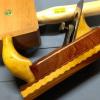I'm getting ready to build a hand tool workbench and have been experimenting with the current 34" bench I use - I expect I'll be one of those that works on a shorter bench. It looks like the 'pinky test' will be appropriate for me, and will wind up with something like 31-32". I'm just under 6 feet but have an ape index of +4 or 1.06, depending on which style you use. Per Chris, I think this means "freakishly long arms". 
I see a lot of discussion about bench height, and I believe that arm length is something that isn't considered often enough in the discussion. In my family, I'm marginally taller than the other males (dad, brother) but my arms are significantly longer and therefore my hands are much lower. Even though we're close on height, our workbench heights would be very different.
daniel
Not all chemicals are bad. Without hydrogen or oxygen, for example, there would be no way to make water, a vital ingredient in beer.





 Reply With Quote
Reply With Quote




